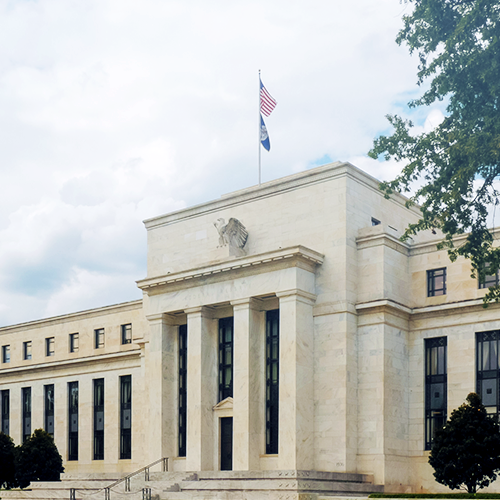
August 2024
Hinting at a Long-Awaited Rate Cut
Inflation and labor-market data will be keys to whether the Fed cuts rates in September.
Download PDFKey Takeaways
- As expected, the Federal Reserve’s Federal Open Market Committee (FOMC) continued to hold the federal funds target rate range at a 23-year high of 5.25% to 5.50%.
- The FOMC softened language around inflation and left the door open for a September rate cut. Markets have priced in a 90% chance of a cut at the Fed’s next meeting.
- The FOMC added language to its July statement putting emphasis on its dual mandate (lowering inflation and maximum employment) rather than simply focusing on stabilizing prices: “The Committee is attentive to the risks to both sides of its dual mandate.”
At their July meeting, Federal Open Market Committee (FOMC) members unanimously agreed to leave the fed funds rate range unchanged at 5.25% to 5.50%. The stand-pat stance was expected, as the market at the start of the week believed there was a 95% chance rates would remain steady. Investors continued to price in a September cut. Expectations for an interest-rate cut started the week at a 90% chance for a 25-basis-point cut at the Fed’s next meeting. At the press conference after the meeting, Chair Jerome Powell seemed to rule out a 50-basis-point cut anytime soon. “I don’t want to be really specific about what we’re going to do, but that’s not something we’re thinking about right now,” he said.
The Fed’s statement took a softer tone from its June meeting to the current state of inflation. It reiterated the central bank’s goal to return inflation back to its 2% target. However, the FOMC also added language about targeting the dual mandate of bringing down inflation and achieving maximum employment.
While investors thought Chair Powell would give hints to the markets about an impending cut in September, the decision still appeared to be kept fairly close to the vest. The latest inflation prints have been encouraging, with inflation in June—measured by the core Consumer Price Index (CPI)—softening for a third consecutive month and showing a broad-based deceleration in core goods, housing, and services prices (excluding housing). Notwithstanding likely upward revisions to the Personal Consumption Expenditures Price Index (PCE) price inflation, expectations for a broad-based slowdown in CPI inflation and a cooldown of the labor market have appeared to raise the FOMC’s confidence for the first interest-rate cut in over four years. In recent communications, Chair Powell and other Fed speakers have also placed more emphasis on the downside risks to the economy. Powell meaningfully changed his characterization of the labor market, referring to “cooling” instead of gradual moderation. All of this in combination with comments made in the press conference might suggest labor-market considerations will play an increased role in the FOMC rate-cut deliberations.
Below are the Fed statement language changes from June:

After the Fed announcement, the 10-year Treasury ended the day lower at 4.09% short and long rates also lower. The Dow Jones Industrial Average and S&P 500 Index returned 0.24% and 1.58% respectively for the day.

10-Year Treasury Yield Over the Last 12 Months

In Conclusion
The fifth FOMC meeting of the year shed a little more light on what market participants have long been waiting for—a cut to the Fed’s benchmark rate. While it came as no surprise the Fed reiterated its higher-for-longer approach, expectations remain strong for the committee to make its first 25-basis-point cut in September. While that baseline call seems reasonable and would likely maintain balance in the markets, growing sentiment among many FOMC members centers around balancing risks, including labor-market data. This suggests the state of the labor market will likely play an increased role in the FOMC’s decision whether to cut rates in September and the last two meetings of 2024.
Rate-cut expectations for the FOMC’s next meeting in September started the day at 90%, according to the CME Group's Fedwatch Tool. While there were no real expectations from investors for the FOMC to cut rates in July, the meeting added to what was a busy week for markets with 34% of the S&P 500 companies releasing their second quarter results. While the committee and Chair Powell delivered some small hints of a possible rate cut in September, we will have to wait and see if trends in the committee’s dual-mandate focus will allow the Fed to meet market expectations at its next meeting.
“The broad sense of the committee is that the economy is moving closer to the point at which it would be appropriate to reduce our policy rate,” Chair Powell said. “The question will be whether the totality of the data, the evolving outlook and the balance of risks are consistent with rising confidence on inflation and maintaining a solid labor market. If that test is met, a reduction in our policy rate could be on the table for as soon as the next meeting in September.”
Definitions:
One basis point is equal to 0.01%.
The Consumer Price Index (CPI) measures the overall change in consumer prices based on a representative basket of goods and services over time. Core CPI is the change in prices of goods and services, except for those from the food and energy sectors.
The Dow Jones Industrial Average index (DJIA) tracks the share price of the top 30 large, publicly-owned U.S. companies which is often used as an indicator of the overall condition of the U.S. stock market.
Gross Domestic Product (GDP) is the total monetary or market value of all the finished goods and services produced within a country’s borders in a specific time period.
Personal Consumption Expenditures (PCE) refers to a measure imputed household expenditures defined for a period of time.
The S&P 500 index is a market capitalization-weighted index of 500 widely held stocks often used as a proxy for the U.S. stock market.
The Summary of Economic Projections (SEP), known informally as the “dot plot,” is a collection of forecasts for the economy, inflation, the labor market, and interest rates offered by the seven Fed governors and 12 regional Fed presidents
Any performance data quoted represent past performance, which does not guarantee future results. Index performance is not indicative of any fund’s performance. Indexes are unmanaged and it is not possible to invest directly in an index. For current standardized performance of the funds, please visit www.AristotleFunds.com.
The views expressed are as of the publication date and are presented for informational purposes only. These views should not be considered as investment advice, an endorsement of any security, mutual fund, sector or index, or to predict performance of any investment or market. Any forward-looking statements are not guaranteed. All material is compiled from sources believed to be reliable, but accuracy cannot be guaranteed. The opinions expressed herein are subject to change without notice as market and other conditions warrant.
Investors should consider a fund’s investment goal, risks, charges, and expenses carefully before investing. The prospectuses contain this and other information about the funds. The prospectuses and/or summary prospectuses should be read carefully before investing.
Investing involves risk. Principal loss is possible.
Foreside Financial Services, LLC, distributor.
Bloomberg Finance L.P. is unaffiliated with Aristotle Capital, Aristotle Funds, their affiliates, their distributors, and representatives.



